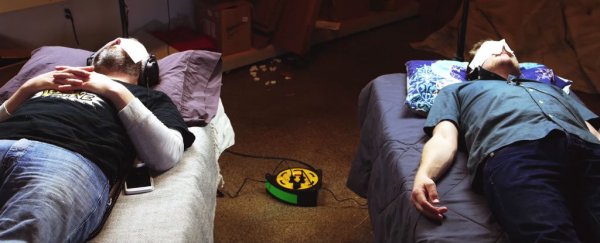The human brain is a remarkable thing. It can do things our primate relatives are thousands - maybe even millions - of years of evolution away from, and our most complex machines are not even close to competing with our powers of higher consciousness and ingenuity.
And yet, those 80 billion or so neurons are also incredibly fragile.
If the tiniest thing goes wrong with a particular connection - maybe something misfires, or a certain neural pathway is blocked - things can fall apart very quickly.
And, oddly enough, even without any injuries or structural malfunctions, the human brain can get weird all by itself - turns out, it's surprisingly easy to trick it into seeing and hearing things that aren't actually there.
And no, we're not talking about taking a bunch of drugs to make yourself hallucinate. The brain can do all that on its own, you just have to know how to manipulate it.
As demonstrated by the guys in this 2016 Scam Nation video on YouTube, if you create a situation of intense sensory deprivation using some common household objects, you can induce some really strong hallucinations that mess with both your sense of sight and sound.
You're going to need:
- Sheets of light, white paper
- Cotton padding
- Rubber bands
- Stationery, including scissors, tape, a stapler, and string
- A YouTube video of old television white noise or static that runs uninterrupted for at least 30 minutes
- Noise-cancelling headphones
Watch the video to find out how they use each of these things to basically deprive themselves of any sensory input, and have a try yourself.
The effects usually start to show after about 10 to 30 minutes.
After 20 minutes, the Scam Nation guys reported seeing "blooms of colour" - like those you see when you rub your eyelids - that would soon form shapes, such as dinosaur silhouettes, jellyfish, and the Eye of Sauron.
One heard screams, and the other heard laughter.
Sounds like nonsense? Well, sure, we have to take the word of two dudes on YouTube for this particular scenario, but what they're doing actually follows the principles of a scientific phenomenon known as the Ganzfeld effect.
The Ganzfeld effect describes how when you're exposed to "an unstructured, uniform stimulation field" - such as seeing blackness and hearing constant television static - your brain responds by amplifying neural noise in an effort to find missing visual signals.
This can result in both visual and aural hallucinations like the guys in the video describe.
Of course, every person will experience the effect in different ways.
When Derek Muller from Veritasium tried his own version of sensory deprivation - locking himself in a pitch-black, ultra-quiet anechoic chamber for 45 minutes - he debunked the myth that the lack of stimulation would send you mad, but did report a few odd sensations.
"Perhaps the weirdest thing I noticed was the sense of my heart," he says.
"I just felt like it was pumping really hard, and I could feel, almost like the blood pushing up through me. It wasn't like I was hearing it, it was like I was feeling it. And I was feeling as though, in a way, my heart was shaking my body. That was something weird."
In this situation, Derek didn't exactly experience hallucinations, but what he describes with his heart does suggest his brain was amplifying things in the absence of any stimuli.
Interestingly, researchers demonstrated a similar effect in an experiment in 2015, where they asked volunteers to stare into each other's eyes for 10 minutes straight.
"The participants in the eye-staring group said they'd had a compelling experience unlike anything they'd felt before," Christian Jarrett reported for the British Psychological Society's Research Digest at the time.
It's an imprecise science, to be sure, because every person's brain responds differently to the weird things we throw at it (figuratively), but you could give the Scam Nation method a try and see what happens to you. Just, if the Supreme Being from Time Bandits gives you a hard time, don't blame us, okay?
A version of this story was first published in April 2016.
